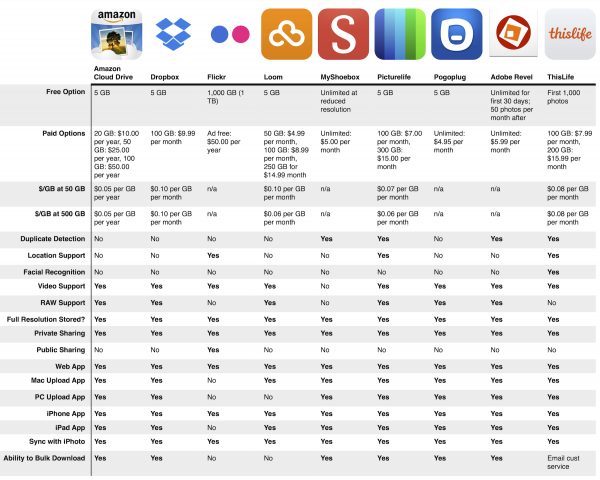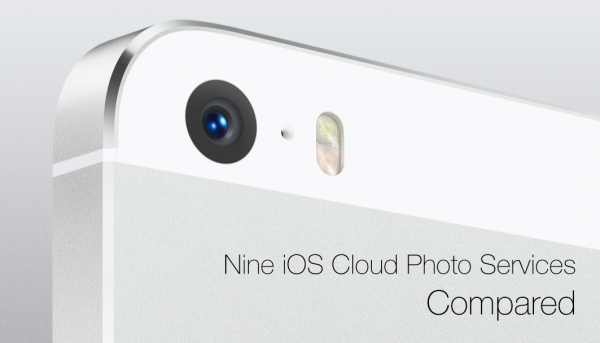Cloud photo storage a tricky proposition these days? We aim to help, with reviews of the major players in this arena.
A little over a year ago, everything changed. My daughter, Peregrine (Pip, for short), was born, and along with the myriad recalibrations, adjustments, and joyous changes that birth brought with it, I also finally came to terms with the true value of the iPhone camera: baby pictures! Hundreds and hundreds of them (no exaggeration) were taken by me, by friends, and by family, and then scattered over hard drives, social networks, and of course iPhones. The problem then became figuring out how to organize and store them privately and securely. As a devoted Mac user it’s easy enough to keep photos stored on iPhoto, but that’s a local option only, with limited cloud storage and sharing (those 1,000 photos on iCloud? Please!), and god forbid my hard drive crashes without proper backup.
I thought all of my problems with cloud storage for photos were solved when Everpix came along. Here was a fantastic, well-designed app that also had great web-based software and a Mac-based uploader. Best of all, it could load in all of my photos from various social streams, eliminate or hide duplicates, and handle a potentially unlimited number of photos for a reasonable monthly or yearly price.
There was just one big problem though; Everpix went out of business.
Before I get to the heart of this article, there are a few lessons to learn from my Everpix experience.
One: Always keep all of your photos on a local hard drive.
Two: Backup said hard drive as often as humanly possible (something I still don’t do, so do as I say, not as I do).
Three: Never, ever assume that a site, app, or service will exist forever. It won’t; it just won’t. They will all go away at some point. Some will last five years. Some will last a year or two. Some of the very best won’t even make it that long.
So I found myself back at square one, trying to find another good (read, as close to the effortless Everpix as I could get) cloud-based storage solution for my photos. Read on for my look at nine different cloud storage services that work with iOS.

What you get: Without any outlay of cash, users can upload an unlimited number of photos (and videos, which is important, as you’ll see later) for the first 30 days after signing up for the service. After that Adobe limits free accounts to 50 photos per month, which isn’t very much, but it IS free after all. Paid accounts are a flat $5.99 a month for unlimited storage and uploads.
Revel has apps on iOS (both iPad and iPhone), Mac, and Windows 8. These apps are worth mentioning as they are more than simple uploaders; allowing folder creation, library management, and minimal editing features. Sharing photos from within the app is limited to only email, iMessage, Facebook, and Twitter.
The Upside: Revel is relatively inexpensive for the premium option with unlimited uploads and storage. There’s a decent free option, and photo editing options on iOS apps are a good touch. The basic but solid PC/Mac apps go a step beyond uploaders. Another plus is that
Revel is an Adobe product so at least the company is solid, even if the product may not be.
Revel did easily take over 80k images and videos without slowing down.
The Downside: No editing via web interface, no tags, location information, or facial recognition, slow uploads, can take up a large amount of drive space as it loads photos to cache when uploading, no watch folders for uploading. The OS X app has an issue with some file types like PNG (iOS Screenshots) and video types. These must be uploaded via the web interface.
Bottom Line: In many ways
Revel is the most barebones of all the available options. Whether that’s a good or a bad thing is a matter of personal taste, but I will say that it seems too sparse for me. Sharing options are basic, and nothing more - which is pretty much a phrase that sums up Revel entirely. The future looks shaky for
Revel. The service hasn’t seen many updates lately, and there’s some online suspicion that it may be folded into
Lightroom.

What you get: The free plan is a plain 5GB, with the possibility of upgrading to 10GB by referring friends to the service. That’s not much storage for those with thousands of photos and/or videos, so
Loom offers 50GB for $4.99 a month, 100GB for $8.99 a month, or 250GB for $14.99 a month (that’s $49.99, $89.99 or $149.99 if a year is prepaid). Apps are currently only available for iPhones, iPads, and Macs, but libraries can be viewed (and photos organized into folders) via
Loom's web interface as well. And there's photo sharing through email, iMessage, Facebook, Twitter, Instagram, or a dedicated
Loom Photo Page.
The Upside: The 50GB plan for
Loom might be viewed as cheaper than
Revel, but
Revel is unlimited. The apps work as advertised.
The Downside: Pricing plans based on the amount of storage used seem contrary to the idea of a service designed to hold all of my photos. The Mac app is decent enough, offering to watch folders and iPhone libraries for new images to upload. The iOS apps are a pretty stripped-down affair, offering only basic organization (just folders - no tags or other more sophisticated methods). There is currently no dedicated Windows or Android support.
Bottom Line: For $1.00 more a month, services like
Revel offer unlimited storage and more robust apps. There’s nothing wrong with
Loom per se, but there’s also nothing that sets it apart from other apps and services yet.
Loom seems to be trying to take the
Everpix torch and has been rapidly updating recently.

What you get: The standard 5GB free plan is included here, with paid plans running from Premium ($7 a month for 100GB) to Premium Plus ($15 a month for 300GB). Besides
PictureLife's presence on the web, apps are available for iPhone, iPad, and Android, with uploaders available for Macs and PCs. Photos can be uploaded from devices and computer hard drives as per usual, but photos from Facebook, Flickr, Foursquare, Google, Instagram, Smugmug, and Tumblr accounts can also be backed-up and stored via the service. Sharing is available via Facebook, Twitter, Tumblr, Shutterfly, and Flickr.
The Upside: The iOS apps serve as more than simple organizers and viewers, providing some very basic editing features like filters (but strangely no crop function). The ability to link and back up photos from social accounts is a major plus, and the sharing options are a little more comprehensive than most services. The web presence of
PictureLife is deep, with some useful options for privacy settings and sharing to family only. There are also some nice touches reminiscent of the dearly departed
Everpix, such as a ‘Memories’ tab that changes each day to show photos from that same day in previous years.
The Downside: The same web presence mentioned above is also cluttered, with an interface that can often confuse even as it offers a variety of choices. And - can I say it again? - tiered pricing for photo storage is an ongoing concern for anyone who is going to continually add more and more photos.
Bottom Line: PictureLife is a definite wait-and-see product. There are hints of really good and even great features, but they're mired in a confusing and overwrought UI. That said,
PictureLife still has real potential, but right now it's just potential.

What you get: MyShoebox offers unlimited uploads for free. However, after a 30 day trial of their Pro Plan ends all photos are kept at a reduced resolution; which is currently 1024 pixels on the longest side. The Pro Plan, at $5 a month (or $48 per year), is required for full resolution photos. Apps are available for iPhone, iPad, Android, Mac, and Windows (the latter two serving only as uploaders) and there is a web interface for viewing and sharing photos. Sharing is available through email, iMessage, Twitter, Facebook, and a
MyShoebox Shared Gallery feature.
The Upside: Unlimited uploads for either free or $5 a month is a solid plus. Time Travel feature on the web provides interesting quick looks at the day in from throughout a user’s photo history.
MyShoebox also organizes photos based on what camera took them, which is a unique feature.
The Downside: The startup process with
MyShoebox left me feeling cold. The Mac uploader stalled several times, causing me to have to exit and restart the app in order to get anything uploaded - and now the Mac uploader seems to be working invisibly in the background, even when I thought I had quit the program. The iPad app has some screens that run only in portrait mode, while others run in landscape, and uploads were slow. There are no photo editing or organizing functions available in any of the apps. The Time Travel feature is not yet implemented in the iOS apps. There are other odd inconsistencies, such as the ability to post photos to Pinterest from within the web site, but not in any of the apps. There is currently no way to link a user’s social accounts to the service to easily back up those photos to
MyShoebox.
Bottom Line: MyShoebox has promise, but it definitely feels like a work in progress at this time. The free unlimited uploads might sound tempting, but there are other ways to achieve this via other more reliable services.

What you get: ThisLife is now a
Shutterfly product that has come and gone and come again. This time it resembles
Everpix in many of its feature sets. The free trial only allows for 1,000 photo uploads; after that, it’s $7.99 a month (or $59 a year) for 100gb or 25,000 photos and videos. Videos are not included in the free trial. Uploaders are available for Mac and PC, plus more fully-featured apps for iPhone, iPad, Android, and Kindle. The web interface and iOS apps are virtually identical. As photos are uploaded, their geolocation is included and facial recognition software goes about organizing the people in photos. Photos can be shared via email or to Facebook and Twitter, and photos from a user’s Facebook, Twitter, Instagram, Flickr, Picasa, SmugMug, and Tumblr accounts can be linked and backed up via
ThisLife.
The Upside: Unlike most, if not all, of the other services in this list,
ThisLife allows for joint accounts. That means, for example, that a couple can link each others’ accounts to one
ThisLife account, backing up all of the photos from two or more people’s devices and social services in one location. Another possible pro to using
ThisLife is the fact that it’s a
Shutterfly product. Users who already have
Shutterfly accounts can easily transfer their photos over to
ThisLife, and creating Photo Books and other
Shutterfly products from within
ThisLife is easy. Uploads are also unusually speedy. Photos can be organized into ‘stories’ (a glorified term for folders), but this organization is not synced with iPhoto. Tags, geolocation, and facial recognition are all big plusses, as is the option to share an account and load in photos from every major photo and social site.
The Downside: There’s no getting around tiered pricing here. Though 25,000 photos for $50 a year is a good start, what happens when a photo/video collection exceeds 25,000? The next step up is 200GB for (currently) $118 a year. The bottom line problem is that this can get very expensive very quickly for those with large or potentially large photo collections. Neither the iOS or web apps have any photo editing features. Finally,
Shutterfly identifies
ThisLife as a beta product; so features, pricing, etc may change at any point. One of our testers also uploaded over 80,000 images and videos to
ThisLife only to find the service to become unusable with that number of images as both the iOS app and web interface just locked up when loaded.
Bottom Line: ThisLife is currently my go-to photo storage solution, but it’s far from perfect. Still, it’s ideal for my wife and I to have a joint account, as we have photos spread all over the place on devices and social networks. Thus far,
ThisLife has uploaded everything we have fairly flawlessly. Of course we’re still well under our 25,000 cap, so I’ll get back to you as we begin to run out of space. Plus,
ThisLife was pulled from
Shutterfly once before; who’s to say it won’t disappear again?

What you get: Flickr recently upgraded its free storage to 1TB, which is impressive in and of itself. And while it isn’t quite the same as the other services in this list, the ability to store so many photos and videos at their original size (up to 200MB each, which still limits video uploads significantly) for free makes it a very attractive possibility.
Flickr was never intended as a private photo backup solution, so sharing options abound - particularly on the web interface.
Flickr can share to pretty much anywhere. Apps are available for iPhone and Android, but sadly there is still no app for the iPad (there are third party solutions to this, most notably
Flickr Studio, but it would still be nice to have an official iPad app). Sharing directly to
Flickr is also built into
iPhoto, making it a potentially more attractive option for Mac users.
The Upside: Did I mention 1TB? Did I mention free? ‘Nuff said!
The Downside: There’s no official iPad app and
iPhoto integration, while nice, can be quite buggy at times. Storing photos from other social networks automatically is not possible from within
Flickr, and having a joint account with another person, while possible, is unwieldy as the service is not designed for it (though there are some rudimentary workarounds). There is no editing functionality in any official
Flickr app - only viewing, tagging, and sharing. And the big one; there’s no way to get more than single images out of the service should you ever need to.
Bottom Line: 1TB is hard to sneeze at. With a few workarounds (and a VERY close eye kept on privacy settings)
Flickr could be a reasonable option, particularly for Mac/
iPhoto users.

What you get: Amazon’s foray into the realm of digital storage is their Cloud Drive - a service that mirrors features similar to
Dropbox, among others. As has become something of a standard, the first 5GB are free with a wide array of pricing tiers following. 50GB is $25 per year, and 100GB is $50, for example. This is not a dedicated photo storage solution, as Amazon’s Cloud Drive can handle any file type. However it’s an option, since there is a dedicated iPhone, iPad, and Android app called
Amazon Cloud Drive Photos (and a Mac/PC app that serves only as an uploader). Sharing is accomplished through these apps to the usual suspects: Twitter, Facebook iMessage, and email.
The Upside: If you use
Amazon Cloud Drive for other storage (above and beyond 5GB especially), this could be a no-brainer, as it can handle so many different types of files.
The Downside: Tiered pricing rears its ugly head again, though in this case it’s more understandable since Amazon is storing far more than photos. Sharing is limited, and there are no photo editing options within the iOS/Android apps.
Bottom Line: If you already have a storage plan with Amazon, the simple storage and viewing options they offer might work well enough. For those searching for a more feature-rich experience, look elsewhere.

What you get: Since we’re on the subject of mass cloud storage options, we would be remiss if we did not mention the granddaddy of them all,
Dropbox. But like Amazon’s Cloud Drive,
Dropbox stores anything and everything and does so in a speedy manner. The first 5GB are free, and 100GB is $9.99 a month. New(ish) tweaks to
Dropbox have added a dedicated photo section to the web, iOS, and Android apps, and the ability to auto upload photos from iOS devices has been added. Sharing is very much like Amazon’s Cloud service, with options to share to Facebook, Twitter, email, and iMessage.
The Upside: It’s
Dropbox, it’s eponymous, and it works as advertised. The photo viewer and uploader do their jobs, but don’t expect much fanfare about it. Sharing is quick and easy.
The Downside: Dropbox isn’t a dedicated photo storage platform and it shows. It’s an option because, frankly, so many users already have
Dropbox accounts and it’s easy to move photos to the platform. It’s also pricey; especially considering the fact that you can get 100GB at Amazon for half the price.
Bottom Line: Dropbox is only an option if a user already has a paid plan and enough storage to handle a catalog of photos. Otherwise, it’s underwhelming. Through company acquisitions and new features in their service, it looks like
Dropbox is looking to make a push into the photo storage arena, so it’s one to watch.

What you get: Pogoplug is yet another contender for the
Dropbox crown. It attempts to serve as a backup for all important files, not just photos. Though, like
Dropbox and Amazon, it has a special category for photo uploads and viewing. The first 5GB are free (sound familiar?), but unlike similar services,
Pogoplug offers unlimited storage for $4.95 per month or $49.95 per year. The service offers rudimentary organization (albums) and sharing (Facebook, Twitter, and email links).
The Upside:
Unlimited storage for a flat monthly or yearly fee is excellent and commendable.
The Downside:
Ever heard of Pogoplug? Neither had we until we started this article. That’s not a criticism of the service they offer, but given the recent failure of Everpix, finding a solution that is going to last for the long-term (at least as the internet views long-term) is important. Dropbox and Amazon aren’t going away anytime soon. Pogoplug? We’ll let you decide.
Bottom Line: If you are looking for dedicated photo storage, look elsewhere. If you’re looking for dependable cloud storage in general, look elsewhere. If you’re willing to try something that’s both affordable and extremely likely to either fold or get purchased by someone else, by all means try
Pogoplug.
Final Thoughts

As the chart above clearly shows, no two services give you exactly the same feature set, and prices can sometimes vary wildly. Ultimately, I'm not looking for a freebie or a handout (though in the case of Flickr, I'll certainly take advantage of it). I want a service that charges a flat monthly/yearly fee for unlimited photo and video storage, that offers joint accounts, and can import photos from all of my various social streams. Right now such a service does not exist.
Writing this article was an exercise in enlightenment for me. I've searched for the very best cloud-based photo storage option since the demise of Everpix, only to discover many services that have bits and pieces of what I'm looking for. As is the case with so many competing products, what I really want is the best of all of the options presented above, but that's unlikely anytime soon. Given the current slate of apps and services, I'm now leaning toward Flickr. 1TB of free storage can hold an awful lot of photos, and services like IFTTT can be leveraged to move all of my future social media photos to the service as well. It's not perfect, but free virtually unlimited storage might make it worth some extra trouble. Are there services/apps we left off our list that you think we should check out? Post us a message on Twitter or Facebook!











